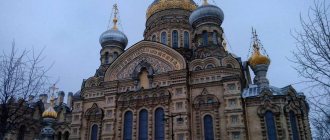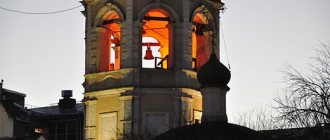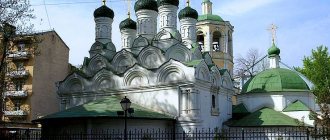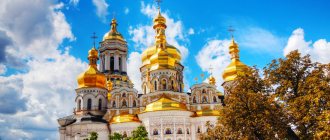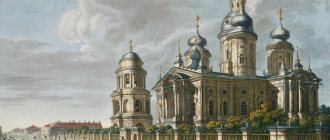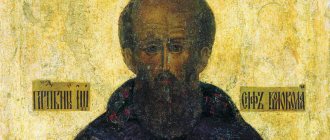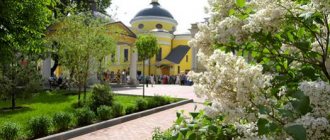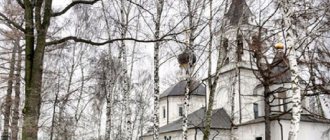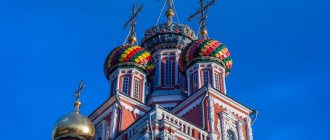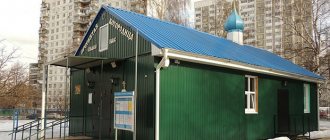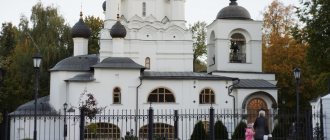This term has other meanings, see Assumption Church.
| Orthodox Church | |
| Spas on Sennaya | |
| Cathedral of the Assumption of the Blessed Virgin Mary | |
| Sennaya Square at the beginning of the 20th century, Assumption Church, Sennaya Market buildings | |
| 59°55′38″ n. w. 30°19′14″ E. d.HGYAO | |
| A country | Russia |
| City | Saint Petersburg |
| Confession | Orthodoxy |
| Diocese | St. Petersburg and Ladoga |
| Building type | Cathedral |
| Architectural style | baroque |
| Author of the project | Andrey Kvasov (with possible participation of Bartolomeo Rastrelli) |
| First mention | 1743 |
| Construction | 1753-1765 |
| Side chapels | The main one is the Assumption of the Blessed Virgin Mary (formerly the Presentation of the Lord); northern - the Council of the Three Saints, Archangel Michael; southern - St. Savva of Storozhevsky, the All-Merciful Savior. |
| Status | lost |
| State | does not exist, a memorial chapel has been erected |
| Media files on Wikimedia Commons | |
Church of the Savior on Sennaya
;
The Church of the Dormition of the Blessed Virgin Mary
is a lost church that was located on Sennaya Square in St. Petersburg. Since 1923 - a cathedral.
The temple was a monument of the late Baroque. The majestic and spacious temple was crowned with five domes standing on multifaceted drums.
In the city, the church was known as the Savior on Sennaya, after one of the chapels - the All-Merciful Savior.
Construction
Merchants from Sennaya Square persistently appealed to the city authorities with a request to build a church since 1743 and received permission to build it 8 years later. On the Vyborg side, a ready-made wooden Church of the Origin of the Honest Trees was purchased and, after being moved, it was consecrated on July 18, 1753 in a new location.
View from the bell tower
The stone church was founded on July 20, 1753 by Archbishop Sylvester. The church was built at the expense of the wealthy tax farmer Savva Yakovlev (Sobakin). In the old days, Bartolomeo Rastrelli was considered the architect; now Andrei Kvasov is recognized as the more likely author of the project, although some authors do not exclude the participation of Rastrelli[1] based on the characteristic plan and proportions of the structure and the elegance of the installation of the main dome. The temple was subsequently expanded by adding two chapels in the name of the Savior and Archangel Michael at the expense of K. I. Novikov[2]. In addition, Rastrelli built Yakovlev’s mansion nearby (not preserved).
The church was planned to be divided into a warm half with two chapels and a single altar cold one. In 1758, the temple was ready, but was not consecrated: a commission of architects proposed to redo the vaults. As a result, the consecration of the first, Three Saints chapel (left) occurred only on June 20, 1761. Under this chapel a crypt was built, into which Yakovlev transferred the remains of his parents from the Sampsonievskoe cemetery. Externally, the church was completed by 1762, and on October 2, 1764, the right side chapel was consecrated in the name of St. Savva, whose name the temple builder bore. On December 5, 1765, the consecration of the main, cold chapel, consecrated in the name of the Presentation of the Lord, took place (later it was reconsecrated in the name of the Dormition of the Mother of God). The image in this chapel was painted by the famous painter Mikhail Kolokolnikov.
As a result, the majestic and spacious church building was crowned with five domes located on multifaceted drums. The majestic three-tier bell tower was crowned with a slightly elongated dome, and a high refectory adjoined it.
The architecture of the temple was designed in a mixed style, transitioning from Baroque to Classicism. The high gilded iconostasis of the temple was considered one of the best in St. Petersburg. Also notable were the paintings in Greek writing and the silver throne weighing 6 pounds 38 pounds[2].
Current state
In 1992, more prosperous times came for the temple. The parishioners turned to the city authorities with a request to return the church to the St. Petersburg diocese. The transfer of the temple complex took quite a long time; it was returned to the parish only in 1994.
However, the first service was held on December 4, 1992. Later (August 2) the border of the holy prophet Elijah was consecrated. And on September 26, 1998, Metropolitan of St. Petersburg and Ladoga Vladimir performed the rite of consecration of the Holy Cross chapel, and on April 7 of the entire church.
Since 1997, the church has continued to be restored. The ceilings, communications and equipment were gradually dismantled. The vaults were cleared of oil paint and the original paintings from the early 19th century were revealed.
By 2011, the area around the temple complex was put in order - the fence was restored, garages and storage buildings were removed. The former factory administration building was demolished. It violated the unified architectural ensemble of the Annunciation Church.
Now there is a social service at the church, and a Sunday school is open. There are also Blagoveshchensk courses and a youth club has been organized. Parishioners travel together to holy places, organize children's Christmas and Easter parties, and help each other.
Social service
The Annunciation Church in St. Petersburg provides free assistance to parishioners, for example, material and organizational. The priests conduct various spiritual conversations and provide moral support.
Employees help people solve housing and legal issues. They provide psychological consultations. Organize care for the elderly and sick.
Sunday School
Experienced teachers teach children the Law of God, read them the lives of saints, and tell them about church holidays. The children are taught fine arts and handicrafts.
Teachers organize joint holiday events, tea parties, and pilgrimage trips.
There are 3 groups, divided by age:
- youngest – 4 – 7 years;
- average – 8 – 11 years;
- eldest – 12 – 16 years old.
Lessons are held on Sunday mornings.
Nursery group
This group is for kids. Teachers work with the children on drawing, handicrafts, and reading books. They are open only on Sundays from 10:00 while the Liturgy is in progress. At the end of the service, parents pick up their children and take them to Holy Communion.
Youth club "Blago"
Club members meet every Sunday at 1:30 p.m. after the Divine Liturgy.
On them, young people discuss various topics, for example:
- social media;
- family life;
- sport;
- self improvement;
- spiritual development and much more.
How the Orthodox worldview helps in various life situations is, perhaps, the main idea of all the conversations.
Blagoveshchensk courses
On Tuesdays at 8:30 people who want to study Orthodoxy more deeply gather. They have conversations with them about important rules of spiritual life, and explain the essence of the Old and New Testaments.
Pilgrimage trips
For parishioners, parish employees and clergy organize joint trips to monasteries, holy places in Russia, Greece, Israel and other countries with rich spiritual traditions.
Children holidays
The parish organizes various children's parties with tea, where the children perform themselves and also watch performances by invited guests.
Lectures and meetings
The temple regularly hosts various interesting meetings with respected and famous figures of science, culture, and art.
Conversations and discussions
The parish holds conversations and debates in an informal setting. They give everyone the opportunity to express their opinion.
Pre-revolutionary history
During the 19th century, the church building underwent a number of changes.
Soon after construction, uneven settlement of the building led to damage to the bell tower. In 1816-1817, the architect L. Ruska created a project for a partial remodeling of the building, combining warm and cold churches together. The entrance to the church was decorated with a multi-columned portico with a pediment, repeating the outlines of the portico of the guardhouse, built according to the design of the same architect[3].
At the beginning of the 20th century. The reciprocal porticoes of the church and the guardhouse, built by L. Ruska, the updated form of the bell tower
Architect A.I. Melnikov built a chapel in the name of the All-Merciful Savior on the south side of the main altar, which was consecrated on January 14, 1822. After this, he was entrusted with repair work.
In 1833-1835, under the rector I. I. Ivanov, the domes and vaults of the church were redone according to Melnikov’s design; On February 14, 1835, the northern chapel was consecrated in the name of Archangel Michael, built by P. F. Votsky.
In 1867-1873, work was carried out to completely remodel the top of the temple and the bell tower: the wooden structures were replaced with brick ones, at the same time the shape of the domes was slightly changed and the porticos were redone. The author of the project was the architect G.I. Karpov. The work began with the renovation of the main church, and after its consecration it was continued in the small one. The new consecration of each throne was complete, since all five thrones were removed from their places; On October 1, 1870, the consecration of the rebuilt temple took place, but the work was not completed and continued until 1873.
As a result of this complex of alterations, according to some contemporaries, by the beginning of the 20th century, the architecture of the building had lost its stylistic unity[4].
In 1897-1898, under the leadership of V.V. Windelbandt, concrete vestibules were added, and the domes were covered with gilded copper.
In 1902-1903, according to the project of I. I. Yakovlev, work was carried out to lengthen the side chapels of the temple, as well as repairs and restoration of icons.
Archpriest Konstantin Nikolsky served in the church for more than half a century (since 1858).
Every year, on August 1, in memory of the deliverance from cholera, a procession of the cross was traditionally held[2].
Church values
The church was huge and visited; its very location and connection to local toponymic objects was a prerequisite for the appearance of unique values in the temple.
Material Treasures
The church was decorated with a high gilded iconostasis, made in the Baroque style with icons from the mid-18th century, which was considered one of the best in the capital. The church had a throne with a gilded rotunda, decorated with silver bas-reliefs, distinguished by the perfection of artistic embossing. Weighing more than 100 kilograms, the unique throne was donated in 1786 by the creator of the temple. Temple builder S. Ya. Yakovlev also presented the temple with a shroud of crimson velvet, embroidered with silver, gold and pearls. For this shroud, a new silver shroud weighing about 115 kg was made in 1856[5]. It was made by the famous jeweler F.A. Verkhovtsev and the tomb for St. Isaac's Cathedral was later made based on the model of this tomb.
Of the images most revered in the temple:
- A local image of the Assumption, framed in a gilded silver frame with a chasuble strewn with pearls.
- List of the Tikhvin Mother of God from the chapel. It was displayed on the porch on June 27 for worship.
- Image of Christ the Savior. Before him, the Vologda community prayed on October 18 in memory of the deliverance of their city from the plague in 1605.
In addition, the large icons “Burial of the Savior” and “St. Andrew, Bishop of Crete” by V. M. Peshekhonov, as well as paintings by the artist G. G. Myasoedov.
Finally, the outstanding value of the temple were the bells. Among the fifteen bells of the temple were the best examples of works of domestic artistic casting. The largest of them was cast in Moscow at the Yason Strugovshchikov plant and weighed 8900 kg[6].
Caring for the flock
Spaso-Sennovskaya Church was a powerful socio-cultural center of St. Petersburg:
- In the 1820s, there was a parish theological school attached to the church.
- The church was considered a special shelter for orphans; widows and orphans of clergy were placed in church houses.
- In December 1871, a Charitable Society was established at the church to help poor parishioners (began to operate on December 16, 1873). The Society had an almshouse for old women and a shelter for children.
In 1903, the clergy of the church asked to raise the temple to the rank of a cathedral, this rank was received in 1923.
Several chapels were assigned to the church: in the Apraksin courtyard, in the Big Line - Tikhvin (existed from 1805; in 1893, according to the design of V. F. Kharlamov, made of cast iron) and Kazan (1800s, 1847 - according to the design of I. D. Corsini , 1879, also made of cast iron, - A. L. Golm), in the Mariinsky market - Mary Magdalene (1882, A. I. Krakau) and in Mikhailovsky Proezd - Ilyinskaya (1850s) and the tented, cast iron All Saints (1916, civil engineer L. M. Kharlamov).
Temple destruction
In the 1920s, all valuables were removed from this church. From 1932 until its closure, the temple served as the cathedral of the renovationist Leningrad diocese[7]. In April 1938, the temple was closed and removed from security.
It was blown up along with the neighboring apartment building on February 1, 1961[8], at the height of another anti-religious campaign.
The order to demolish the temple was given by the chief architect of Leningrad, Valentin Kamensky. "IN. A. Kamensky, replacing N.V. Baranov after the war, condemned him for the strategic shortcomings of the current general plan of the city, the imperfection of low-rise residential construction in the first post-war years, etc. Having learned about N.V. Baranov’s threats, V.A. Kamensky demanded that hosted “their own academicians” E. A. Levinson, I. I. Fomin, etc.) in order to achieve the signing of a document on the complete worthlessness of the Church of the Assumption of the Blessed Virgin Mary in the panorama of Sennaya Square.” They signed the document on the demolition of the temple[9].
“The explosion was scheduled for the night of February 1-2, 1961. But no matter how much the metro builders rushed, they were still late. A day before the explosion, GlavAPU received a letter from E. A. Furtseva with a ban on destroying the Church of the Assumption of the Blessed Virgin Mary, which has the unique historical and architectural significance of a large religious building of the mid-18th century. The letter was read there, sealed again and sent by express to the Lenmetrostroy Department, where they did not dare to open the letter and returned it back to GlavAPU on Saturday, February 1, a non-working day.”[9].
Before the explosion, the copper and gold-plated roof was dismantled[10]. Fearing damage to the houses standing in the square, engineers calculated the explosion so that its force would go into the ground; however, there is information that as a result of the explosion even the piles of St. Isaac's Cathedral were damaged[11]. The rubble of the bombed temple was cleared. On the vacant site, according to Kamensky’s design, the lobby of the ground exit of the Ploshchad Mira metro station (renamed on July 1, 1992, after the square, Sennaya Ploshchad) was built. It was opened on July 1, 1963[12].
How are the services held, schedule?
Services are held in the church every day.
| Confess | At 9:30 |
| Liturgy (daily) | From 10:00 |
| All-night vigils | On Saturdays after 16:00 |
| Requirements | Every day |
Akathists are read on certain days at 17:00.
| Monday | Saint Tikhon of Zadonsk |
| Wednesday | Mother of God |
| Thursday | Nicholas the Wonderworker |
| Sunday | Savior |
The Annunciation Church, located in St. Petersburg, is an ancient unique building of the 18th century. Today the temple complex is the center of spiritual life in the Vasileostrovsky district.
Recovery plans
Since the 1970s, the architect-restorer D. A. Butyrin has been involved in the restoration of the temple. He created a reconstruction project and sought its implementation. In the event that complete restoration of the church would be impossible, Butyrin proposed to recreate at least the bell tower in order to return the lost dominant feature to Sennaya Square[13].
Since the 1990s, after the collapse of the USSR, activities to recreate the church intensified, and signatures were collected in support of the project. The idea enjoyed the support of the townspeople; about 15 thousand signatures were collected, which were handed over to the administration of St. Petersburg[14].
In the early 2000s, the project was signed by the chief architect of St. Petersburg Oleg Kharchenko, permission was received from the Committee for State Control, Use and Protection of Monuments and the blessing of Metropolitan Vladimir. All signatures necessary for the implementation of the project were collected[15]. The project has not yet been implemented, but in memory of the bombed church on Sennaya Square in 2003, a chapel was built.
In 2011, active development of the project for the restoration of the Church of the Assumption of the Blessed Virgin Mary on Sennaya Square began.
In the same year, work began on the restoration of the temple. The builders were faced with the task of opening up the asphalt and calculating the approximate location of the cathedral. It turned out that the old foundation was not destroyed. The architects were especially delighted by the cathedral's holy of holies - the altar base. Not far from the altar slab, a sealed entrance to the crypt of the Savior was found - a buried entrance to the cellars of the church. Usually priests and noble parishioners were buried in the crypt[8]. Most likely, Spas on Sennaya will be restored on the old foundation.
| Object of cultural heritage of Russia of regional significance reg. No. 781530232440005 (EGROKN) object No. 7830849000 (Wikigida DB) |
In 2014, by order of KGIOP No. 10-102 dated March 11, 2014, the foundation of the church was recognized as an object of cultural heritage of regional significance[16]. Now any type of work is prohibited on this site, except for landscaping the territory and restoring the church building[17].
Where is the church
The temple complex is located at the address: 199004, St. Petersburg, V.O., no. 68. It is located on the 7th line of Vasilyevsky Island.
- Telephone.
- Website: hramblag_spb.
You can get to the church from the Vasileostrovskaya metro station on foot along the 6th and 7th lines.
Walk approximately 350 m towards the embankment of the Smolenka River or Maly Prospekt. Or they also move on foot along the 8th and 9th lines in the same direction. There is also a path from the metro station “Sportivnaya” (780 m.) or “Chkalovskaya” (2.7 km.).
Notes
- Kan P. Ya.
Walks around St. Petersburg. - St. Petersburg: Palitra, 1994. - 412 p. — ISBN 5-289-01813-1. - ↑ 123
Guide to St. Petersburg. Reprint. reproduction ed. 1903. - St. Petersburg: Icarus, 1991. - ISBN 5-85902-065-1. — P. 182. - The guardhouse building was located in the northern corner of the square, opposite the church, across Sadovaya Street and has survived to this day.
- A. P. Pavlov
? - Seven pounds
- 542 pounds 18 pounds
- Levitin A., Shavrov V.
Decline of Renovationism. // Essays on the history of Russian church unrest.] - ↑ 12
The foundation of the Church of the Savior on Sennaya was discovered in St. Petersburg. Orthodoxy and peace. - ↑ 1 2 Smirnov V.V.
The nasty story of the blessed memory of Yuri Mikhailovich Denisov, an architectural historian, is dedicated. // Architecture, restoration, design, investment, construction. - No. 1(19). — 2003. - The reconstruction of the church on Sennaya began quietly. Fontanka.ru, 09/19/2014.
- Zhdanov A. M.
“Sennaya Square” // Metropolitan of St. Petersburg: metro legends, projects, architects, artists and sculptors, stations, ground vestibules / Andrey Zhdanov. - M.: Tsentrpoligraf, 2022. - P. 255. - 2000 copies. — ISBN 978-5-227-07543-7. - The vestibule was not built on the site of the bombed temple, but next to its foundation: only the left edge of the steps reaches it. St. Petersburg metro. Line 2, Stations and tunnels on the St. Petersburg Internet newspaper website.
- Katrunova E. I. Reconstruction project of the Church of the Assumption of the Virgin Mary on Sennaya Square by architect D. A. Butyrin Archival copy dated June 17, 2022 on the Wayback Machine // Current problems of theory and history of art. SPb., 2012. P. 413
- Vishnevsky B.
Temple as an inheritance. In memory of the architect Dmitry Butyrin // Novaya Gazeta St. Petersburg: Newspaper. - St. Petersburg, 2010. - Issue. 22 (March 29). (unavailable link) - Dmitry Butyrin: “I’m sure that Mityurev is being led by the nose” // Stepanov A.D.
Russian Line: Electronic media. - 2009. - Issue. April 24. - “On the inclusion of the landmark “Church of the Assumption of the Blessed Virgin Mary “Spas on Sennaya” in the unified state register of cultural heritage objects (historical and cultural monuments) of the peoples of the Russian Federation, on the determination of its subject of protection, the plan of the boundaries of the territory and the nature of the use of the territory, restrictions on the use of this territory and requirements for the nature of economic activity, design and construction"
- Perevalov E. The new temple will save Sennaya from the “Bermuda Triangle” Archival copy of March 22, 2014 on the Wayback Machine // RBC, 03.21.2014
